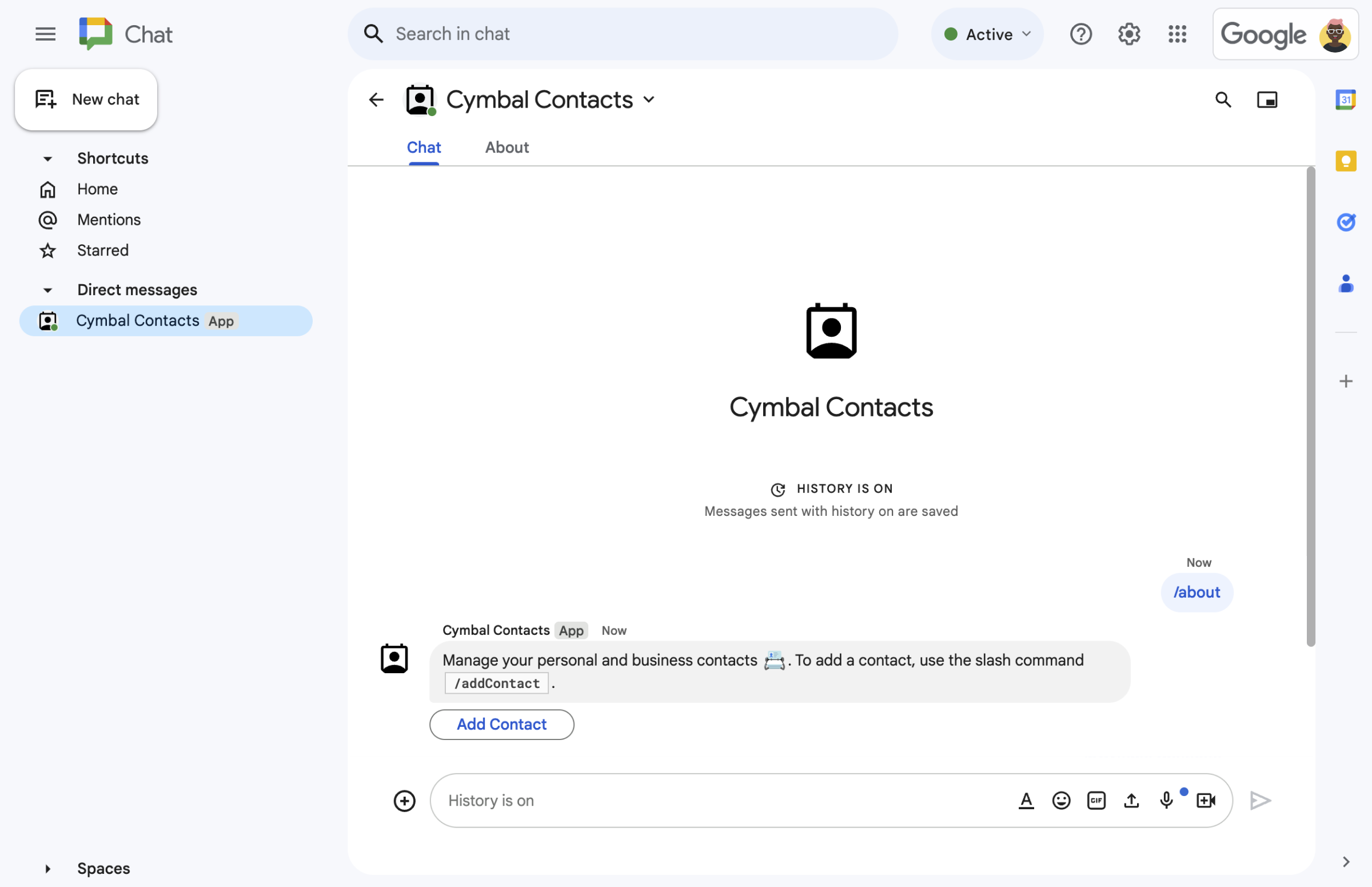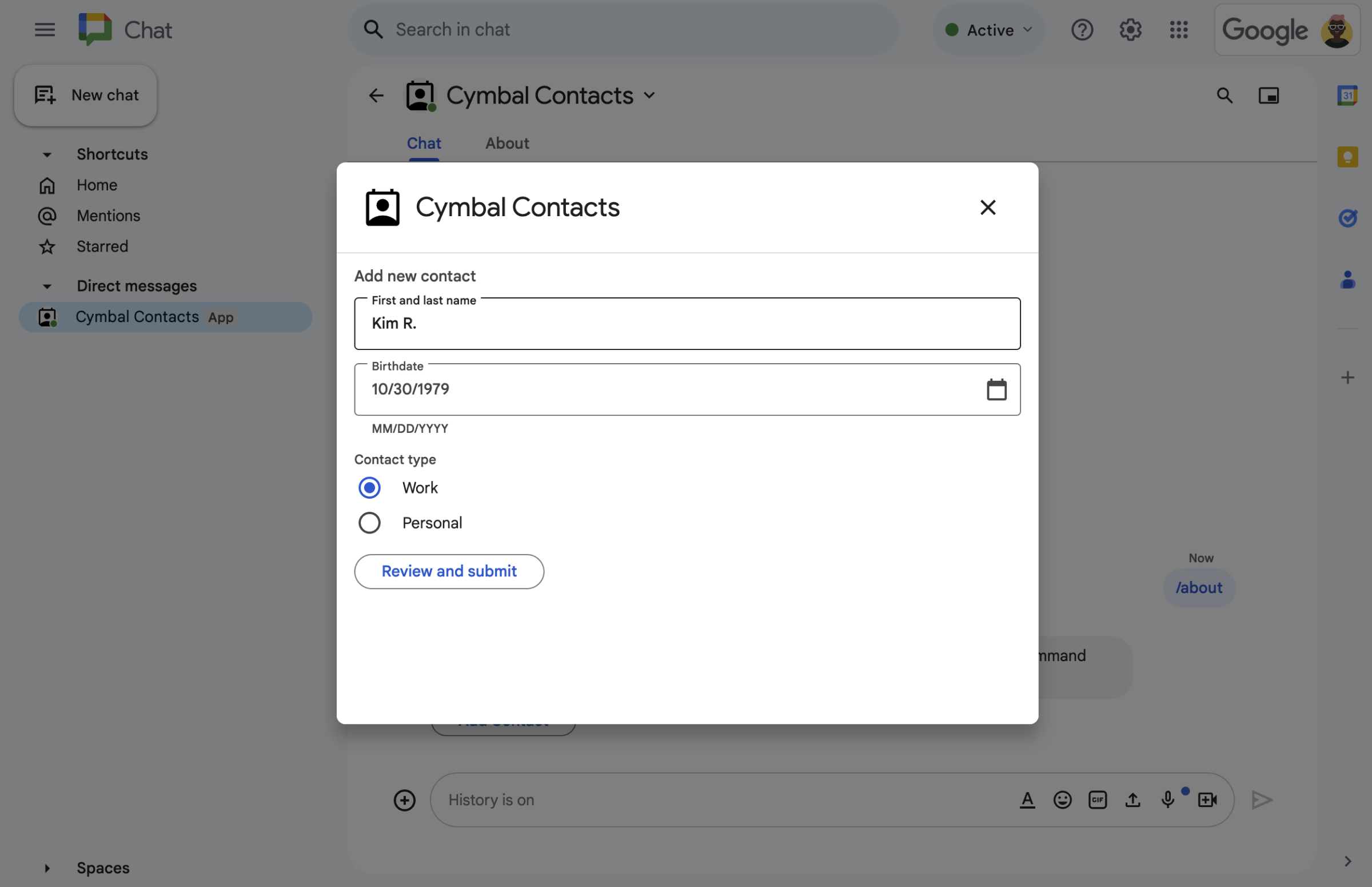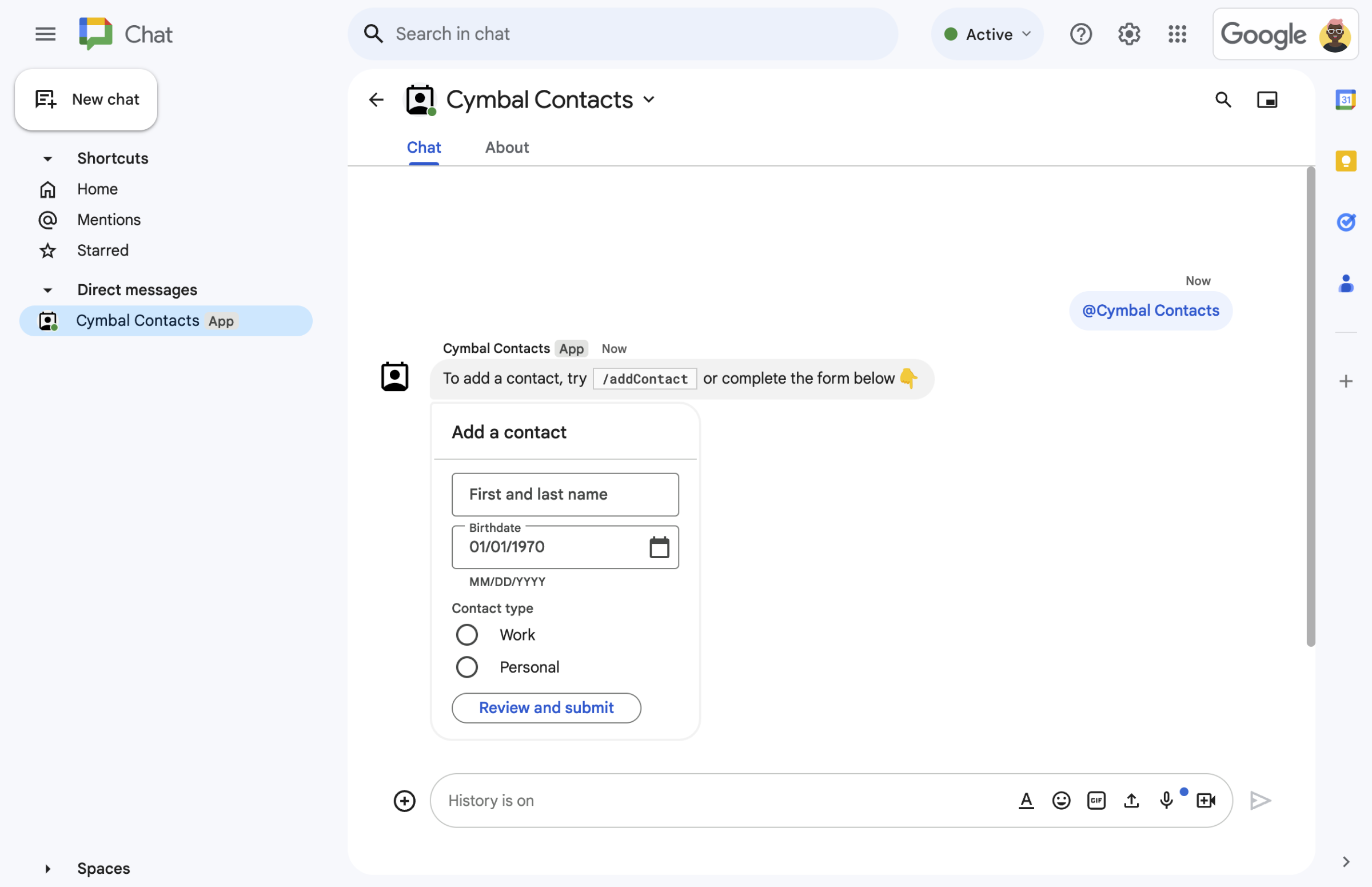This page explains how Google Chat apps can send messages to reply to user interactions.
In Google Chat, add-ons appear to users as Google Chat apps. To learn more, see the Extend Google Chat overview.
-

Figure 1. A Chat app responds to a slash command with a text message and button. -

Figure 2. A Chat app opens a dialog where users can input information. -

Figure 5. A Chat app sends a message with text and an interactive card.
Prerequisites
Node.js
A Google Workspace add-on that extends Google Chat. To build one, complete the HTTP quickstart.
Apps Script
A Google Workspace add-on that extends Google Chat. To build one, complete the Apps Script quickstart.
Design the message
Chat apps can include any of the following in a message:
- Text that contains hyperlinks, @mentions, and emoji.
- One or more cards, which can appear in a message or open in a new window as a dialog.
- One or more accessory widgets, which are buttons that appear after any text or cards in a message.
To learn about designing messages, see the following Google Chat API documentation:
- Messaging overview
- Format messages
- Build cards for Google Chat apps
- Add text and images to cards
- Add interactive UI elements to cards
Reply with a message
Chat apps can respond with a message to any of the following triggers or interactions:
- Message triggers, such as when users @mention or direct message a Chat app.
- Added to space triggers, such as when users install the Chat app from the Google Workspace Marketplace or add it to a space.
- Button clicks from cards in messages or dialogs. For example, when users input information and click submit.
Otherwise, Chat apps can send messages proactively by calling the Google Chat API.
To reply with a message, return the action DataActions with a
CreateMessageAction object:
{ "hostAppDataAction": { "chatDataAction": { "createMessageAction": {
"message": MESSAGE
}}}
Replace MESSAGE with a
Message
resource from the Chat API. To learn more about how actions work, see
Chat actions.
In the following example, a Chat app creates and sends
a text message whenever it's added to a space. To send a text message when a
user adds your Chat app
to a space, your Chat app responds to the
Added to space trigger by returning the action DataActions:
Node.js
/**
* Sends an onboarding message when the Chat app is added to a space.
*
* @param {Object} req The request object from Google Workspace add-on.
* @param {Object} res The response object from the Chat app. An onboarding message that
* introduces the app and helps people get started with it.
*/
exports.cymbalApp = function cymbalApp(req, res) {
const chatEvent = req.body.chat;
// Send an onboarding message when added to a Chat space
if (chatEvent.addedToSpacePayload) {
res.json({ hostAppDataAction: { chatDataAction: { createMessageAction: { message: {
text: 'Hi, Cymbal at your service. I help you manage your calendar' +
'from Google Chat. Take a look at your schedule today by typing' +
'`/checkCalendar`, or schedule a meeting with `/scheduleMeeting`. To learn' +
'what else I can do, type `/help`.'
}}}}});
}
};
Apps Script
/**
* Sends an onboarding message when the Chat app is added to a space.
*
* @param {Object} event The event object from Chat API.
* @return {Object} Response from the Chat app. An onboarding message that
* introduces the app and helps people get started with it.
*/
function onAddedToSpace(event) {
return { hostAppDataAction: { chatDataAction: { createMessageAction: { message: {
text: 'Hi, Cymbal at your service. I help you manage your calendar' +
'from Google Chat. Take a look at your schedule today by typing' +
'`/checkCalendar`, or schedule a meeting with `/scheduleMeeting`. To learn' +
'what else I can do, type `/help`.'
}}}}};
}
The code sample returns the following text message:

For additional examples of how to respond with a message, see the following guides:
- Respond to quick commands
- Respond to slash commands
- Open interactive dialogs
- Collect information from Google Chat users
Update a message
Chat apps can also update messages that they send. For example, to update a message after a user has submitted a dialog or clicked a button an a message.
To update a Chat app message, return the action
DataActions with a
UpdateMessageAction, as shown in
the following example:
{ "hostAppDataAction": { "chatDataAction": { "updateMessageAction": {
"message": MESSAGE
}}}}
Replace MESSAGE with a
Message
resource from the Chat API.
To learn more about how actions work, see Chat actions.
Chat apps can also update a message from a user, to return a preview of a link that they sent. For details, see Preview links in Google Chat messages.
Reply to interactions or send proactive messages using the Google Chat API
Instead of returning an add-on action, Chat apps might need to use the Google Chat API respond to an interaction. For example, Chat apps must call the Google Chat API to do any of the following:
- Send messages on a schedule, or about changes to external resources. For example, notifications about a new issue or case.
- Reply more than 30 seconds after the interaction. For example, to respond with a message after completing a long-running task.
- Send a message outside of the space where the interaction took place.
- Send a message on behalf of a Chat user.
To send a message using the Chat API, you must set up authentication
and call the create() method on the Message resource. For steps, see
Send a message using the Google Chat API.
Related topics
- Build Google Chat interfaces
- Respond to quick commands
- Respond to slash commands
- Open interactive dialogs
- Collect information from Google Chat users
- Preview links in Google Chat messages
- Send a message using the Google Chat API